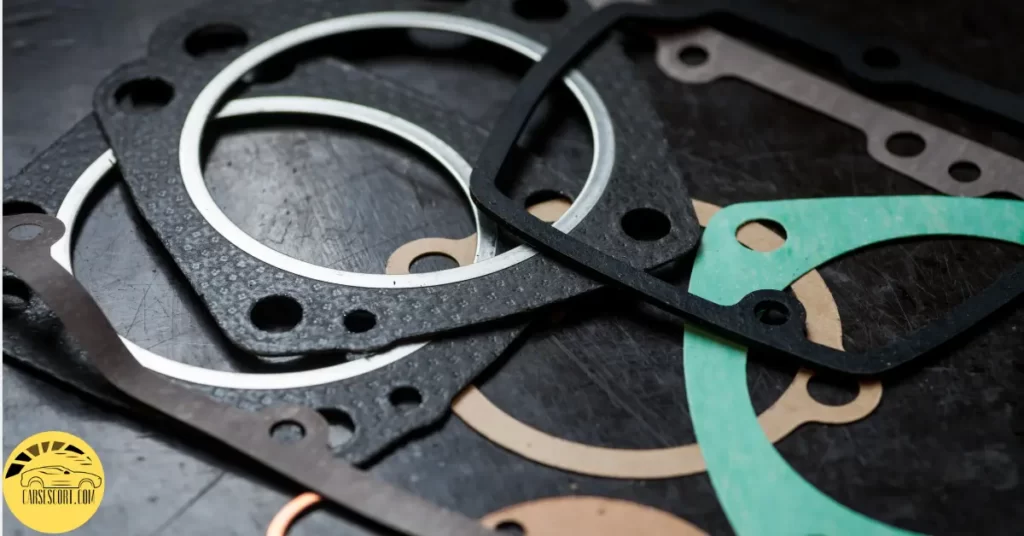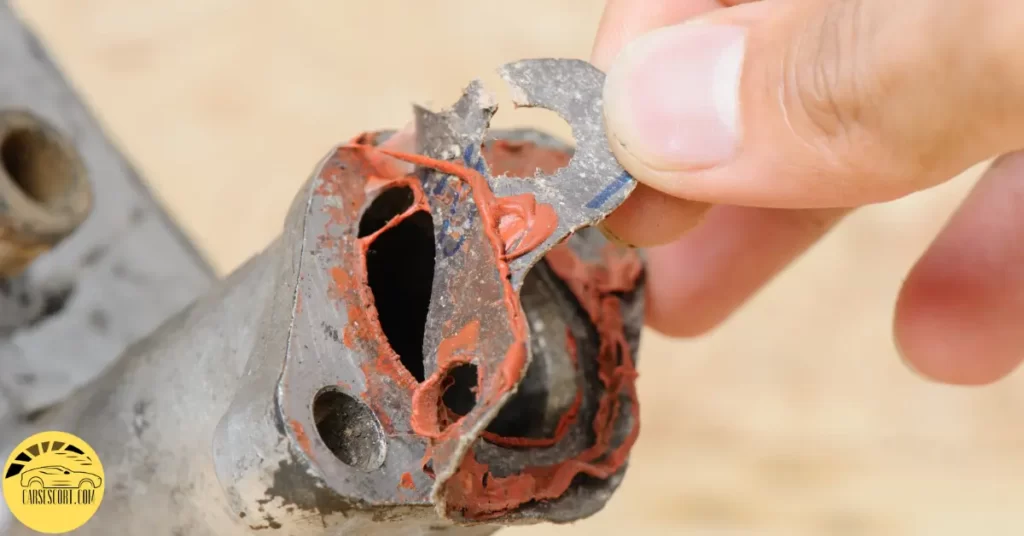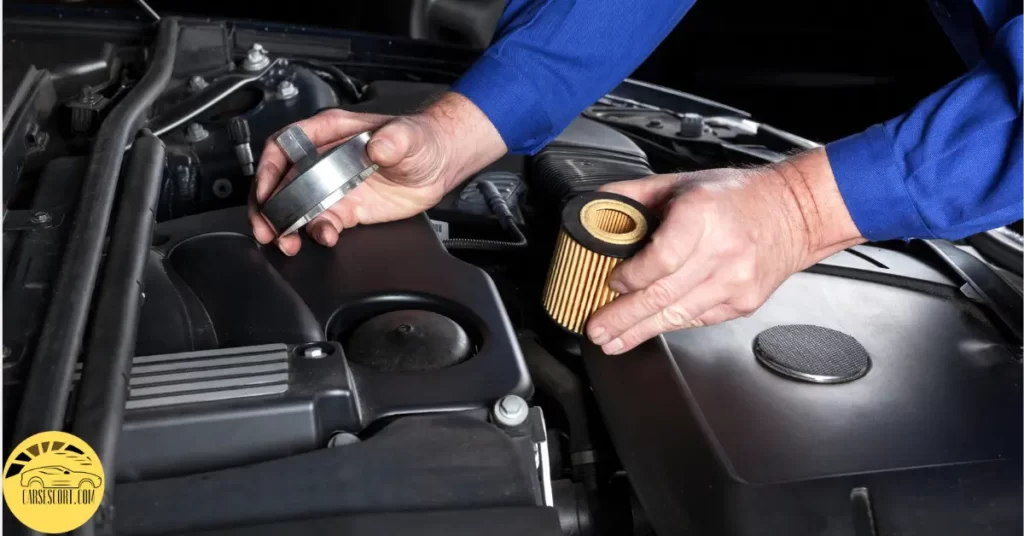Yes, you can apply a thin film of RTV silicone sealant to the corners of the water pump gasket or the stepped casting areas with a gap. However, do not use silicone sealant on the entire gasket or cork gaskets for automatic transmission or engine oil pans.
- When dealing with water pump gaskets, RTV silicone sealant can be used as an additional measure to ensure a proper seal.
- Applying a small amount of sealant to the corners of the gasket and the stepped casting areas that may have gaps can help prevent leaks and enhance the overall effectiveness of the gasket.
- Using the sealant sparingly is crucial to avoid excess material interfering with the gasket’s functionality.
What About RTV Silicone Gasket Maker?
RTV silicone gasket maker is a sealant commonly used to create gaskets or seals in various applications. RTV stands for “Room-Temperature Vulcanizing” indicating that this silicone-based sealant cures or hardens at room temperature.
RTV silicone gasket makers are typically available in a paste or liquid form and are used to create a flexible and durable seal between two surfaces.
They are known for their excellent resistance to high temperatures, making them suitable for sealing engine components, exhaust systems, and other automotive applications.
One of the advantages of RTV gasket makers is their ability to conform to irregular surfaces, providing a tight and reliable seal. They can be used on various materials, including metal, glass, ceramic, and plastics.
Should I Use RTV On Water Pump Gasket?
- You can use RTV silicone on a water pump gasket. RTV silicone is commonly used as a gasket sealant to provide a reliable and leak-free seal between mating surfaces.
- When applying RTV silicone to a water pump or valve cover gaskets, clean the surfaces thoroughly and remove any old material or residue.
- Apply a thin, even layer of RTV silicone to one side of the gasket, then carefully position it onto the pump.
- Allow the RTV silicone to cure according to the manufacturer’s instructions before installing the pump. This will help ensure a proper seal and prevent leaks.
Try Our Recommendation: Permatex 81878 Ultra Copper Maximum Temperature RTV Silicone Gasket Maker
When To Use RTV On Water Pump gaskets?
Regarding water pump gaskets, RTV can be used in specific situations. Here are some instances when Room Temperature Vulcanizing is typically used on water pump gaskets:
Gasket Replacement
If you need to replace the water pump gasket and the new gasket is unavailable, or you prefer to create a custom gasket, RTV can form a reliable seal. It can fill irregularities and gaps between the mating surfaces, ensuring a tight and leak-free connection.
Gasket Repair
In some cases, the existing water pump gasket may develop a leak or show signs of wear. Applying a thin layer of Room-Temperature Vulcanizing on the damaged areas can help restore the integrity of the gasket and prevent further leakage.
High-Temperature Applications
Water pumps may operate at high temperatures in specific systems, such as engines or industrial machinery. RTV silicone sealants are designed to withstand elevated temperatures, making them suitable for applications where traditional gaskets may fail.
Sealing Small Imperfections: If the mating surfaces of the pump and its housing have minor imperfections or unevenness, RTV can be applied to fill those gaps and ensure a proper seal.
It acts as a flexible and durable barrier, preventing leakage or seepage.

Tips for Using RTV with Gaskets
When using RTV (Room Temperature Vulcanizing) silicone with gaskets, there are several tips to keep in mind to ensure a successful and effective application.
1) Clean and Prepare Surfaces
Before applying the RTV silicone, ensure the surfaces where the gasket will be placed are clean and free from dirt, oil, or residue.
Use a suitable solvent or cleaner to remove contaminants, and ensure the surfaces are dry before proceeding. This step is crucial to achieving a strong bond and preventing potential leaks.
2) Apply the Right Amount
Apply the silicone in a thin and even layer to the surface where the gasket will be installed. Avoid applying too much, as excess material can squeeze out and interfere with the gasket’s proper fit or create a messy appearance.
Aim for a consistent thickness that provides sufficient coverage without excessive buildup.
3) Use a Suitable Gasket
Select a gasket compatible with the specific application and intended use. The material should withstand the temperature, pressure, and chemical exposure it will encounter.
Consult the manufacturer’s recommendations or consult with an expert to ensure the gasket’s compatibility with the RTV and the operating conditions.
4) Allow Sufficient Curing Time
RTV silicone requires adequate curing time to reach its full strength and sealing properties. Follow the manufacturer’s instructions regarding the recommended curing time.
Being patient and allowing the silicone to cure fully is important before subjecting the assembly to any stress or operating conditions. Premature handling or exposure to fluids can compromise the integrity of the seal.
5) Avoid Over compression
When tightening the bolts or fasteners that secure the gasket, don’t over compress the gasket or overtighten the fasteners. Over compression can lead to gasket deformation or damage, resulting in leaks or improper sealing.
6) Check for Proper Alignment
Ensure the gasket is aligned with the mating surfaces before tightening the fasteners. Misalignment can cause uneven compression and result in leaks or a compromised seal. Use alignment pins or dowels if necessary to assist in achieving accurate positioning.
7) Inspect for Leaks
After the RTV has fully cured and the assembly is in operation, periodically inspect the gasket area for any signs of leaks.
Look for any fluid seepage or weeping around the gasket and address any issues promptly.
You May Also Like To Read:
Common Uses of Room-Temperature Vulcanizing in Automotive
Gasket Making
RTV is often used to create custom gaskets for sealing engine components. It can be applied to surfaces such as cylinder heads, oil pans, water pumps, and valve covers to provide a reliable seal and prevent leaks.
Engine Assembly
Room-Temperature Vulcanizing is used during engine assembly to seal gaps and prevent oil or coolant leaks. It can be applied to specific areas such as the oil pan, timing cover, water pump, and intake manifold to ensure a tight seal and proper engine functioning.
Transmission and Differential
RTV seals transmission and differential housings, preventing fluid leaks and maintaining proper lubrication.
Electrical Insulation
RTV can create a protective barrier around electrical connections, preventing moisture and other contaminants from causing damage. It helps to maintain reliable electrical connections in various automotive components.
Windshield Installation
The sealant is used to bond windshields to the vehicle body. It provides a strong and durable seal, preventing water leaks and ensuring the windshield remains securely in place.
Exterior Trim and Body Panel Bonding
It can be used for attaching exterior trim pieces and bonding body panels. It provides a strong bond and helps to create a seamless appearance.
Brake System
It can seal brake caliper housing, preventing fluid leaks and maintaining proper brake performance.
HVAC System
It can seal air conditioning and heating system components, such as fittings, hoses, and vents, preventing refrigerant or air leaks.
Exhaust System
It can seal joints and connections in the exhaust system, preventing leaks and reducing noise.
Repair and Maintenance
It is a versatile sealant used for various repair and maintenance tasks in automotive applications. It can be used to seal leaks in hoses, pipes, and other components and to fill gaps and cracks.

How To Properly Seal A Water Pump Gasket?
- Ensure you have the necessary tools and replacement gasket.
- Clean the mating surfaces of the water pump and engine block thoroughly to remove any old gasket material or debris.
- Examine the pump and gasket for any signs of damage or wear. If the gasket appears worn or damaged, replace it with a new one.
- Apply a thin layer of gasket sealant to both sides of the gasket. The sealant helps fill any imperfections in the mating surfaces and provides an additional sealing layer. Use a sealant compatible with your specific engine and gasket material.
- Carefully place the gasket onto the water pump, aligning the holes in the gasket with the corresponding holes in the water pump. Make sure the gasket sits evenly and covers the entire mating surface of the pump.
- Align the pump with the engine block, ensuring that the gasket lines up with the corresponding holes in the engine block. Gently press the water pump against the engine block to create a seal.
- Begin tightening the water pump bolts in a crisscross pattern to ensure even pressure distribution. Gradually tighten the bolts to the manufacturer’s recommended torque specification.
- Avoid over-tightening, as it can damage the gasket or the water pump housing.
- After tightening the bolts, wipe away any excess sealant that may have squeezed out from the edges of the gasket. Use a soft cloth or fiber towel to ensure a clean and tidy finish.
- Depending on the type of sealant used, it may require some curing time. Consult the manufacturer’s instructions for the recommended curing time before adding coolant or starting the engine.
FAQ
Is It Safe To Use RTV On Water Pump Gaskets?
Using RTV silicone on water pump gaskets is safe and effective. RTV forms a flexible seal that can withstand temperature and pressure fluctuations in the cooling system.
However, it is essential to use the appropriate type of RTV specifically designed for high-temperature applications and follow the manufacturer’s instructions.
Will the steel seal fix the water pump leak?
Steel seal is designed to seal cracks or leaks in the engine’s cooling system. While it may be effective for certain types of leaks, such as those in the cylinder head or engine block, fixing water pump leaks is generally not recommended.
The water pump has a specific function that requires proper sealing to maintain efficiency. It is best to address leaks by repairing or replacing the gasket or the pump itself, depending on the extent of the damage.
Do water pump paper gaskets need sealant?
Water pump paper gaskets typically do not require sealant. These gaskets are designed to create a reliable seal between the water pump and the engine block or timing cover. They are usually made of high-quality paper or fiber material with built-in sealing properties.
Applying sealant to water pump paper gaskets is unnecessary and can interfere with proper functioning. Following the manufacturer’s instructions and installing the gasket dry, ensuring a clean and smooth surface for optimal sealing is advisable.
Should I use Permatex on a water pump gasket?
Permatex is a well-known brand that offers various sealants and gasket makers, including RTV silicone. Using Permatex or any other suitable RTV silicone sealant can be beneficial when it comes to water pump gaskets.
Should I use RTV on the oil pan gasket?
Using RTV silicone on the oil pan gasket can be a suitable approach to ensure a reliable seal. RTV provides flexibility and resistance to oil, making it effective for sealing the oil pan.
Before applying cleaning, the mating surfaces of the oil pan thoroughly, and the engine block or timing cover is essential.
Apply a thin, continuous bead of RTV silicone along the oil pan gasket, ensuring complete coverage without excessive squeezing out.
Do Fel-Pro water pump gaskets need sealant?
Fel-Pro is a reputable brand known for manufacturing high-quality gaskets, including water pump gaskets. Generally, Fel-Pro water pump gaskets are designed to provide a reliable seal without additional sealant. These gaskets are engineered to fit precisely and create a tight seal between the water pump and the engine block or timing cover.
It is recommended to install Fel-Pro water pump gaskets following the manufacturer’s instructions and without applying any sealant unless specifically instructed otherwise by the manufacturer.
Affiliate Disclosure: Cars Escort is a participant in the Amazon Services LLC Associates Program. As an Amazon Associate, we earn from qualifying purchases made through affiliate links on our site. Read Our Disclaimer .

